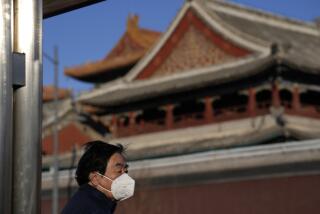21st Century Role for Quarantines
- Share via
The battle against severe acute respiratory syndrome, or SARS, has brought back something that most people know only from history books: quarantine.
Some critics tell us that quarantine -- restraining the movement of people to prevent the spread of infectious disease -- is unworkable and ineffective and deserves to be put back on the shelf. Modern medicine, civil rights and technology have made quarantine impractical and obsolete, we are told.
But history suggests this assumption is mistaken.
Until about 1850, the “miasmatic” theory of epidemic illnesses dominated medical thinking: Foul vapors in the air, or “miasms,” were believed to be the primary sources of outbreaks. The idea of person-to-person transmission of “fevers” was ridiculed. Quarantine was dismissed as unhelpful at best.
The germ theory was first championed by Edward Jenner at the close of the 18th century, and then by Louis Pasteur in the mid-19th century. It taught that epidemic disease resulted from bringing uninfected people into contact with infected ones.
Absent an effective vaccine (such as for smallpox or rabies) or cure (there were none), public health officials had to depend on sanitary measures. Sanitation of streets and buildings; destruction of infection sources such as the clothes of a smallpox victim or mosquitoes in a yellow fever zone; quarantine of road, rail and ship traffic; and home or hospital isolation of patients and their contacts -- all this helped to combat contagion.
Many epidemics of plague, smallpox, yellow fever and influenza were successfully contained by interrupting the transmission of germs. This fundamental fact of germ theory has not changed over time.
Critics claim today that quarantine laws are a return to the “colonial era” and that they conflict with efforts, starting with the Supreme Court under Chief Justice Earl Warren, to protect civil rights that we now take for granted. Yet not only under Warren but also under chief justices Warren Burger and William Rehnquist, and as late as 1997, the Supreme Court validated earlier decisions that said quarantine and other emergency anti-epidemic measures were justified by the extraordinary danger imposed by deadly epidemics of yellow fever and smallpox.
History also affirms that people will cooperate in times of quarantine if authorities communicate a clear and reasonable plan. Providing for the safety of the community in times of emergency is essential to the guarantee of civil liberty.
Yet another criticism is that global travel in the 21st century make quarantine impossible: The spread of disease will always outrun any attempt at containment. This criticism also fails to take into account historical fact.
By 1850, rail travel from New Orleans to Chicago took only three days. The national economy depended on people traveling long distances for commerce in sugar, cotton, coal and other staples. The transatlantic crossing by that time took little more than a week.
Cholera, yellow fever and smallpox take one to two weeks to incubate in a healthy person, providing more than enough time for intercontinental travel during the disease latency period. Yet quarantine measures, when properly applied, enjoyed public cooperation and success in limiting epidemics.
Outbreaks of smallpox (Boston, 1872), yellow fever (New Orleans, 1905) and plague in both its bubonic and pneumonic forms (Los Angeles, 1924) make a strong case for the practical benefit of quarantine.
In the Los Angeles case, the plague was diagnosed on Oct. 31, 1924, from the autopsy of a boardinghouse resident. Twenty-five similar cases of suspected plague had broken out in the downtown Macy Street district; a quarantine was declared, apparently by state health officials. Ill patients were isolated in local hospitals, and contacts or suspected cases were quarantined in their homes.
In all, more than 3,000 people were quarantined in their homes, and there was good cooperation among members of the community, the state health department and the U.S. Public Health Service. Although there were 30 cases initially detected (with a fatality rate near 90%), there were only 11 secondary cases. The drop in the numbers indicated the quarantine had stopped the rapid spread of the plague, and the quarantine was lifted after 12 days.
Medicine, law and technology have made enormous strides over the last century. Technologically sophisticated rapid detection, response and communications systems such as those demonstrated by the World Health Organization and the Centers for Disease Control in recent days are indispensable. Quarantine orders -- as in Singapore, China, Canada and an American Airlines jet in San Jose -- must be sensitive to individual liberties.
In Ontario, Canada, for example, the initial quarantine was voluntary, and officials estimate that thousands of people complied. They eventually took legal action against two people who refused to quarantine themselves. In addition, some hospitals with SARS patients were asked to restrict new admissions to emergency cases.
Where no medical cure is available -- as with SARS or Ebola or in the event of a smallpox bioterror attack -- quarantine is a valuable resource and cannot be ignored.
*
James S. Bromberg is a family physician. Charles Vidich is an urban and public health planner. Both are in the master’s program at the Harvard School of Public Health.






